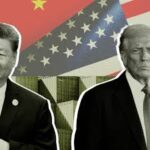On October 30, 2025, President Trump and China’s President Xi Jinping met at Gimhae Air Base near Busan, South Korea — their first face‑to‑face since earlier in the year. Following the meeting, Trump announced a significant set of trade and economic measures:
Key Agreements
- The US will reduce tariffs on Chinese imports from ~57% to ~47% overall.
- The “fentanyl‑related” tariff on Chinese goods (previously ~20%) will be cut to ~10% immediately.
- China agrees to resume purchasing U.S. agricultural products (notably soybeans) and to ease export controls on rare earth elements and critical minerals for at least one year
- Trump said China and US would discuss chip‑export restrictions and indicated that U.S. company Nvidia may enter talks with Chinese counterparts
- Both leaders signalled a potential broader cooperation on geopolitical issues including the Ukraine conflict.
- They agreed to high‑level reciprocal visits: Trump plans to visit China in April 2026; Xi will visit the U.S. “some time after that”.
Trump described the meeting as “amazing” and rated it “12 out of 10”.
Why This Matters
Trade and tariffs
- Bringing tariff average down to ~47% is a substantial de‑escalation. It signals a thaw in the trade war and may lower cost pressures for U.S. importers and consumers.
- The reduction of the fentanyl‑linked tariff shows trade policy linking to non‑trade issues (drug control) — a new angle in US–China relations.
- Rare‑earths and critical‑minerals deal is notable: China has vast control in that space and U.S. industries (military, high‑tech, EVs) are sensitive to supply disruptions. The one‑year deferral gives breathing room.
Tech & strategic implications
- The reference to Nvidia and chip talks suggests that U.S. tech firms may see easier access to China, though major export control frameworks (especially high‑end AI chips) likely still remain contested.
- The fact that strategic/geopolitical topics (Ukraine, rare earths) were raised indicates this is more than a simple trade deal — this may signal a broader shift in how U.S. and China engage.
What’s Still Unclear / Watch‑Points
While Xi and Trump reached broad agreement, no full comprehensive deal has been signed yet; many details remain to be finalised.
Key strategic issues like Taiwan, high‑end semiconductor export controls, full rare earth liberalisation were less emphasised or omitted.
The “one‑year” nature of the rare earths deal suggests this may be a temporary pause rather than a permanent fix.
Markets may have already “priced in” some of the positive scenario; hence, future upside may be limited if deliverables lag.
Implementation risk: China or U.S. may under‑deliver. The framework demands rigorous follow‑through.
What’s Next
- Expect an agreement signature possibly as soon as next week according to U.S. Treasury Secretary Scott Bessent.
- Watch for chip export/tech trade regulations, particularly whether U.S. firms gain broader access to Chinese market (and vice‑versa) and how U.S. export‑control regimes adapt.
- Monitor rare earths/minerals flows, supply‑chain changes and pricing in high‑tech sectors (EVs, batteries, semiconductors).
- Agricultural‑trade flows: Will China ramp up U.S. soybeans/sorghum purchases? That will matter for U.S. farm income and rural sentiment.
- Keep an eye on geopolitical shifts: how U.S.–China cooperation (or competition) evolves on Ukraine, AI, military tech.
- Markets: Risk that the “deal done” narrative is ahead of actual execution. Investors should temper expectations for immediate large gains and focus on implementation signals.
The meeting between Trump and Xi marks a significant de‑escalation in the U.S.–China trade war. The tariff cuts, rare‑earth deal, and agricultural commitments are meaningful. But this should not yet be seen as a “final” peace — many strategic risks remain, implementation is key, and both sides maintain leverage. For businesses and investors, this opens opportunities (e.g., easier trade flows, reduced supply‑chain risk) but also calls for caution: the path ahead still has bumps.










